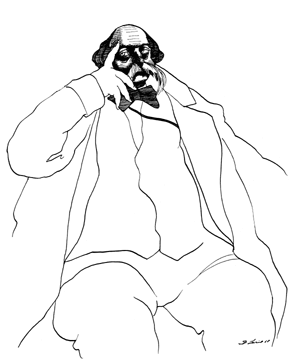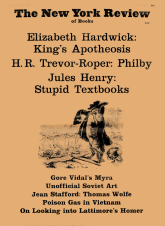The relationships between an author’s life and his work, between biography and literary criticism, are always puzzling. Does it matter what kind of a man he was? And if so, just how much and in what ways does it matter? This is particularly difficult in the case of Flaubert, because of his famous saying “Madame Bovary, c’est moi.” In a preliminary study (Search for a Method, 1963) Sartre attacks the problem with verve and ingenuity: “going back to his biography, I discover his dependence, his obedience, his ‘relative being,’ in short all the qualities which at that period were commonly called ‘feminine.’ At last I find out, a little late, that his physicians dubbed him a nervous old woman and that he was vaguely flattered. Yet it is certain that he was not to any degree at all an invert.” (Sartre’s italics)
Unfortunately for Sartre’s theory, this turns out to be wrong. Dr. Starkie, on the basis of unpublished passages in Flaubert’s letters to Louis Bouilhet, thinks it probable that he had experience of “some homosexual practices”; and Professor Bart agrees that Flaubert was to some degree bisexual. It therefore becomes impossible to follow Sartre’s theory any further along this line; the moral of that would seem to be that if you are committed to a biographical theory, you have to master all the documentation.
In Flaubert’s case this is apparently very difficult, so enormous is the mass of letters and papers he left, some of it unpublished and some only recently available to scholars. Mr. Steegmuller has had to make many changes in his admirable book since it was first published in 1939, while Dr. Starkie and Professor Bart have dug out a mass of new material. From them we learn first a great deal about the gross body of the “Norman giant”: his chronic syphilis and other venereal diseases, his obesity and his epilepsy. Bart is especially interesting on the last: it can be diagnosed as temporal lobe epilepsy, a kind of petit mal with visual disturbances. Flaubert put the experience of his attacks to good use in the Temptation of Saint Anthony and less obviously, as John C. Lapp points out in an essay in Madame Bovary and the Critics, in his greatest novel. Harry Levin mentions Flaubert’s shingles, “more appropriately diagnosed in his case as Saint Anthony’s fire.” I think that all these and many other clinical details really do matter, since Flaubert, the doctor’s son, who as a child peered in at the window to watch his father dissecting cadavers, believed in casting “le coup d’oeil médical” over everything—one remembers the operation of Hippolyte’s club-foot and Hanno’s leprosy. His belief that spirit was inseparable from matter, his faith in positivism and science lie at the heart of his fiction: “être la matière” is the final temptation to which his Saint succumbs. It is appropriate that his biographers should follow his example.
IT WOULD also be appropriate for them to try to follow the Master in the important matter of style. There is nothing very mysterious about Flaubert’s famous style: he simply cast and recast each sentence many times over, until it had its perfect musical form and also expressed precisely what he had in mind. But even for such an immensely fluent writer, as his correspondence shows him to have been, this took an immense amount of time and labor; his dedication to the craft laid down standards for all novelists to come.
His new biographers vary greatly in style, and the quality of their writing is in inverse proportion to the amount of scholarly material they present. Steegmuller’s book is a classic of literary journalism, beautifully arranged in balanced sentences. Enid Starkie writes incisive prose which approaches Flaubertian clarity but lacks any great charm; while Bart, who gives the greatest amount of new and valuable information, as a stylist hardly gets of the ground. The difference is most marked in their use of Flaubert’s letters and other source material. Steegmuller’s middle section, describing the oriental journey, consists entirely of direct quotation, cunningly connected into a marvelous narrative; Starkie makes excellent use of the letters to Louise Colet, translating them with sparkle (though leaving quotations from the novels in French). Bart, however, quotes and translates very little, but paraphrases almost everything, from letters and novels alike: “The Parnassus was before him as the sun rose, showing all its snow, he wrote… The orgy was becoming dangerous when Hamilcar’s daughter Salammbo descended from the palace into the garden. Her presence had a calming effect…two barbarian chieftains were particularly intoxicated by her enigmatic, distant beauty…” and so on. It is sad that the effort that has gone into Bart’s biography should have been partly nullified by this stylistic fault, which drops a gray curtain between the reader and the drama of Flaubert’s sentences.
Advertisement
The life of Flaubert, in English—there was also a pleasant one by Philip Spencer a few years ago—has become almost a minor genre, and this seems right, since Flaubert has been for a century the patron saint of the Anglo-Saxon as much as of the French novel. His books will always irritate those critics who are looking for deep spiritual significances or for ethical messages, and will always delight those who are interested in the problem of perfect artistic communication. The two new biographies do not add much directly to the critical discussion: they offer a good deal of well-informed argument about realism and romanticism, but these terms may no longer seem very relevant to the assessment of Flaubert’s genius: it is agreed that he is not a Realist and that Madame Bovary is not an attack on Romanticism. It is impossible, however, to say just what it is about: from such a rich and ambiguous work of literature critics will go on extracting perfectly valid meanings for centuries to come.
But the main point of the book seems to me a very simple one, and its simplicity gives it its universality. Everyone, like Madame Bovary, has fantasies about love, wealth, travel, and other possibilities of widening experience; almost everyone will have these fantasies frustrated and almost everyone is subjected to the double pressure of money and of boring human contacts. The “bourgeoisie” in Flaubert’s special sense will always be with us; the shining world of ideas and experiences will go on turning into a dictionary of clichés before our eyes; Rodolphe will always prove to be a boor, Léon a prig in the end. Meanwhile there are bills to be paid, the last one of which will be collected by death. This theme is treated with tragic intensity in Madame Bovary, and it is the most authentic tragedy of the nineteenth century, hardly surpassed even by Ibsen, who must have learned so much from it.
ELSEWHERE Flaubert turns this theme into satire and comedy, and with great success. Here I seem to differ from the majority of his ordinary readers, who evidently do not find him very funny. Neither the Temptation of Saint Anthony nor Bouvard et Pécuchet is much read today, and they are usually described as tedious expressions of Flaubert’s obsessive ideas. Perhaps they appeal only to those who have acquired a certain minimum of useless learning, who have wasted their time neither in productive scholarship nor criticism but just in reading what there is to be read, like the two clerks and like the Master himself. For those who have crossed a threshold of knowledge about early Christianity and comparative mythology (perhaps Gibbon and The Golden Bough will do), the Temptation can be a wonderfully funny book, and can reveal itself as a deep parable about the possibilities and limitations of the human mind.
Bouvard et Pécuchet is not only a great satire on the intellectual scene of nineteenth-century France but a permanently true tragicomedy of all human education. The two clerks take up agriculture, landscape gardening, antique collecting, archaeology, history, literature; they suffer existentialist despair and religious conversion, then have doubts; they become educationalists. Everything falls to pieces in their hands, and at last they return to their true métier of copying documents, where alone they will find happiness. Flaubert is mocking himself and by implication anyone who strays from his own little corner of expertise. Yet the clerks, absurd and clumsy figures like Laurel and Hardy moving a piano, are wholly heroic in their quest for enlightenment.
The true heir to the comic Flaubert, as Ezra Pound noticed long ago and as Hugh Kenner has reminded us so well in The Stoic Comedians, is James Joyce. No one could ever improve on Madame Bovary, but in the other field Joyce finally surpassed his teacher. Dubliners derives from and is inferior to “Un Coeur Simple” in Trois Contes, the Portrait owes a little to the Education Sentimentale but does not attain to its lyrical clarity; but in Ulysses he produced a gigantic and triumphant extrapolation of Bouvard et Pécuchet. In the final chapters, where Joyce describes the ludicrous furniture of Bloom’s mind, the utterly banal is transmuted into the pure unearthly beauty that Flaubert strove for.
But the Temptation was Joyce’s greatest love, as it was Flaubert’s. It is the basis of the phantasmagoria in the “Circe” chapter, where Bloom has nightmare visions of sexuality, power, and persecution. It is also one of the models for Finnegans Wake, a cosmic dream of the whole human past, into which Joyce put all his learning, salacity, and humor. Joyce worked on his book for fifteen years, Flaubert on the Temptation for nearly all his working life. In the end, each became lost in a labyrinth of his own making; but failure on this heroic scale is more interesting than lesser men’s success. Flaubert’s life, as his biographers present it and as he himself saw it, was no less a failure, and no less a magnificent triumph.
Advertisement
This Issue
May 9, 1968




